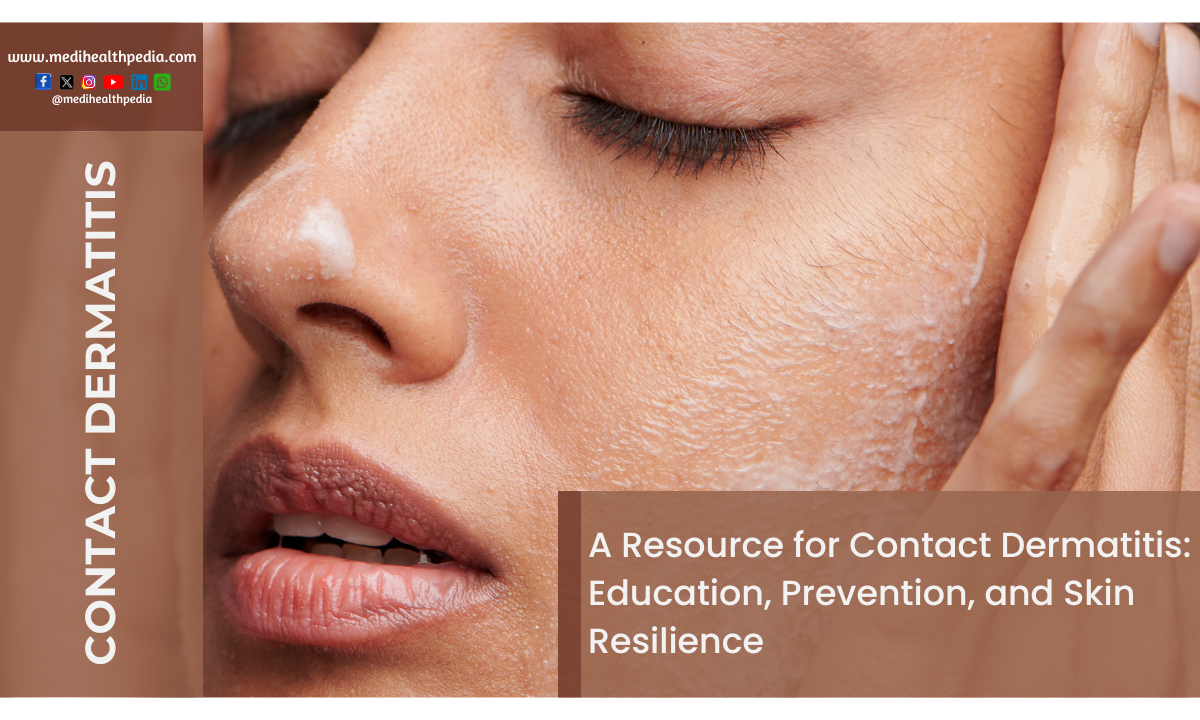Understanding Contact Dermatitis: Clinical Presentation, Workup, and Comprehensive Treatment Strategies - An Overview
Introduction
Skin is not just our body’s largest organ; it also serves as our first line of defense against the outside world. Despite its resilience, skin is vulnerable to various conditions, and one of the most common is contact dermatitis. In this comprehensive guide, we will explore contact dermatitis in detail, including its clinical presentation, differential diagnosis, workup, conventional treatment, prevention, herbal remedies, lifestyle modifications, and conclude with insights on living with this condition.

Clinical Overview
Contact dermatitis is an inflammatory skin condition that occurs when the skin comes into direct contact with a substance that triggers an allergic or irritant reaction. It can manifest as redness, itching, and sometimes blistering or peeling. The condition is widespread, affecting people of all ages, and can be acute or chronic. It is vital to understand the two primary forms of contact dermatitis:
- Allergic Contact Dermatitis
Allergic contact dermatitis is an immune response that develops after repeated exposure to a particular substance. The body becomes sensitized to this substance, and subsequent exposures can lead to a reaction. Common allergens include poison ivy, nickel, fragrances, and certain preservatives in cosmetics.
- Irritant Contact Dermatitis
Irritant contact dermatitis is not related to an immune response but occurs when the skin is exposed to an irritant repeatedly. This can be due to harsh chemicals, detergents, or other irritants. Individuals who work in jobs requiring frequent handwashing or exposure to chemicals are particularly susceptible.
Clinical Presentation
The presentation of contact dermatitis can vary widely depending on the individual and the specific irritant or allergen involved. However, some common signs and symptoms include:
- Itching: One of the earliest and most prevalent symptoms, itching can range from mild to severe, leading to discomfort and sleep disturbances.
- Redness (Erythema): The affected area often becomes red and inflamed due to increased blood flow to the site of the reaction.
- Rash: A rash typically appears, characterized by raised, bumpy, or blistering skin. The rash may ooze, especially in cases of severe dermatitis.
- Dry, Cracked Skin: Prolonged exposure to irritants can result in dry, cracked skin, which can be painful and prone to infection.
- Burning Sensation: Patients may experience a burning or stinging sensation in the affected area.
- Swelling (Edema): Swelling may occur, especially in cases of severe allergic reactions.
The distribution of the rash can also be indicative of the type of contact dermatitis. Allergic contact dermatitis often appears at the site of contact with the allergen, whereas irritant contact dermatitis is more likely to affect areas that are frequently exposed to irritants, such as the hands.
Differential Diagnosis
Several skin conditions can mimic the symptoms of contact dermatitis, making it essential to consider differential diagnoses, such as:
- Atopic Dermatitis (Eczema)
Atopic dermatitis is a chronic condition characterized by itchy, inflamed skin, which can be easily confused with contact dermatitis. However, atopic dermatitis is typically associated with a personal or family history of allergies and often presents in childhood.
- Psoriasis
Psoriasis is a chronic autoimmune condition that can cause red, scaly patches on the skin, which might resemble contact dermatitis. However, psoriasis has a different underlying mechanism and often has a genetic component.
- Seborrheic Dermatitis
Seborrheic dermatitis presents with red, scaly, and itchy skin, often affecting the scalp, face, and other areas with high sebum production. It can resemble contact dermatitis but has distinct characteristics.
- Tinea (Ringworm)
Fungal skin infections, like ringworm, can produce circular, red, and scaly rashes that may be mistaken for contact dermatitis.
It’s crucial to consult a healthcare professional for an accurate diagnosis, as treatments and management strategies can vary significantly between these conditions.
Workup
To diagnose contact dermatitis and determine the causative agent, healthcare providers often follow a systematic approach:
- Clinical Evaluation
A thorough physical examination, including a detailed medical history, is essential. The doctor will inquire about the patient’s exposure to potential irritants or allergens, the duration of symptoms, and any relevant personal or family history.
- Patch Testing
Patch testing is a standard method for diagnosing allergic contact dermatitis. Small amounts of potential allergens are applied to the skin using adhesive patches. These patches are left in place for 48 hours before being removed and evaluated for any reactions.
- Skin Biopsy
In some cases, a skin biopsy may be necessary to rule out other conditions or to provide additional information about the inflammation and its causes.
- Allergy Testing
Allergy testing, such as blood tests for specific allergen antibodies (IgE) or skin prick tests, can help identify allergens that may be triggering the dermatitis.
Conventional Treatment
The treatment of contact dermatitis typically involves a combination of strategies to relieve symptoms and prevent future flare-ups. Conventional treatments may include:
- Topical Corticosteroids
Topical corticosteroids are anti-inflammatory creams or ointments that can help reduce redness, itching, and inflammation. They are available in various strengths, and their use should be guided by a healthcare provider.
- Topical Calcineurin Inhibitors
For patients who cannot use corticosteroids, especially on sensitive areas like the face, topical calcineurin inhibitors like tacrolimus or pimecrolimus may be prescribed.
- Emollients and Moisturizers
Emollients and moisturizers can help keep the skin hydrated, reducing the risk of dryness and cracking. They also provide a protective barrier.
- Avoidance of Irritants and Allergens
Identifying and avoiding the irritants or allergens responsible for the dermatitis is crucial. This often involves making lifestyle changes or using protective measures.
- Oral Antihistamines
Oral antihistamines can help relieve itching, especially if it’s severe and affecting sleep.
- Wet Compresses
Wet compresses can provide relief from itching and inflammation, particularly when applied to affected areas.
- Short-Term Use of Systemic Corticosteroids
In severe cases, or when contact dermatitis covers a significant portion of the body, a healthcare provider may prescribe short-term systemic corticosteroids. These are typically used for a limited duration due to potential side effects.
- Antibiotics
If the skin becomes infected due to open sores or blisters, antibiotics may be necessary.
Prevention
Preventing contact dermatitis involves understanding and avoiding the triggers. Here are some essential prevention strategies:
- Identify and Avoid Allergens and Irritants
Learn to recognize the substances that trigger your dermatitis and take steps to avoid them. This may require changes in your occupation or daily routines.
- Protective Measures
Use protective clothing, gloves, or barrier creams when working with irritants or allergens. This is particularly important for individuals in high-risk occupations.
- Skin Care
Maintain good skincare practices by using mild soaps and moisturizers. Avoid overwashing and using harsh products.
- Allergy Testing
Consider allergy testing if you have a history of contact dermatitis or if your condition is chronic. Identifying specific allergens can guide avoidance strategies.
- Be Mindful of Personal Care Products
Read product labels and be aware of the ingredients in cosmetics, soaps, and other personal care items. Choose fragrance-free or hypoallergenic options when possible.
Herbal Medicines
In addition to conventional treatments, some individuals turn to herbal supplements as complementary or alternative options for managing contact dermatitis. It’s important to note that while some herbs may offer relief, their efficacy can vary from person to person, and scientific evidence supporting their use is often limited. Always consult with a healthcare provider before trying herbal remedies, and be cautious of potential allergies or adverse reactions. Here are a few herbs commonly used for contact dermatitis:
- Aloe Vera
Aloe vera is known for its soothing and anti-inflammatory properties. Applying aloe vera gel to the affected area can help alleviate itching and reduce redness.
- Calendula
Calendula, also known as marigold, has anti-inflammatory and antimicrobial properties. Calendula creams or ointments may be used to reduce inflammation and promote healing.
- Chamomile
Chamomile has anti-inflammatory and soothing properties. You can make chamomile tea and use it as a wash or apply chamomile creams to the affected area.
- Lavender
Lavender oil is well-regarded for its calming and anti-inflammatory effects. It can be diluted with a carrier oil and applied topically to alleviate symptoms.
- Turmeric
Turmeric contains curcumin, which has anti-inflammatory and antioxidant properties. A turmeric paste can be applied to the affected skin, but be cautious as it may stain.
While these herbs may offer relief, it’s important to reiterate the significance of individual variability. What works for one person may not work for another, and some individuals may be allergic to certain herbal remedies. Always seek professional guidance and do a patch test before applying any herbal remedy to a larger area of the skin.
Lifestyle Modification
Making certain lifestyle modifications can significantly reduce the frequency and severity of contact dermatitis:
- Clothing Choice
Opt for loose-fitting, breathable clothing made of natural fibers like cotton. This can reduce friction and irritation on the skin.
- Personal Care Products
Choose hypoallergenic and fragrance-free personal care products to minimize exposure to potential irritants.
- Hand Hygiene
If you have irritant contact dermatitis on your hands, switch to mild, moisturizing soaps and use hand sanitizers that contain moisturizers to reduce the impact of frequent handwashing.
4. Gloves
Use protective gloves when handling irritants or allergens. Be sure to choose the right type of gloves for the specific task.
5. Dietary Considerations
While dietary changes are not a primary treatment for contact dermatitis, some individuals find that reducing certain foods, such as dairy or processed foods, can help alleviate skin conditions. Discuss dietary changes with a healthcare provider.
6. Stress Management
Stress can exacerbate skin conditions. Engage in stress-reduction techniques, such as yoga, meditation, or deep breathing exercises.
Conclusion
Contact dermatitis can be a challenging and uncomfortable condition to manage, but with the right strategies, you can effectively mitigate its impact on your life. It’s crucial to recognize the type of contact dermatitis you’re dealing with, whether allergic or irritant, and work with healthcare providers to determine the specific irritants or allergens responsible.
Conventional treatments, such as topical corticosteroids and moisturizers, play a fundamental role in symptom management. Additionally, herbal remedies may offer some relief, but their effectiveness varies from person to person.
Prevention is key, and understanding the triggers of your contact dermatitis is essential. Take steps to avoid irritants and allergens, use protective measures, and adopt a proper skincare routine to minimize the risk of flare-ups.
In conclusion, while contact dermatitis can be a persistent condition, it is manageable with the right approach and professional guidance. By combining conventional treatments, herbal remedies, lifestyle modifications, and preventive measures, you can regain control over your skin health and lead a more comfortable life. Remember, your dermatologist is your best partner in this journey, providing personalized guidance and treatment plans to suit your specific needs.

